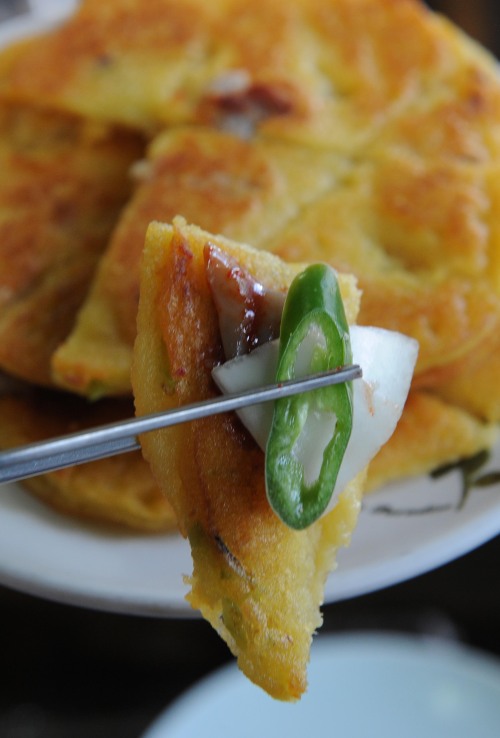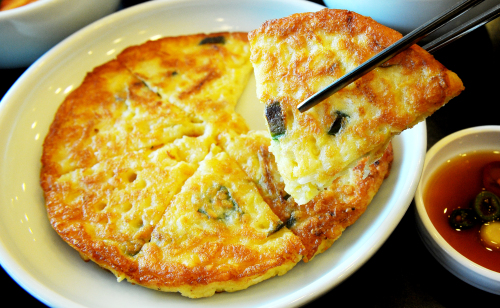In the quiet of a weekday afternoon ― when the cold spins out a strange, solemn silence ― several patrons rush into a small restaurant called Yeolcha Jip.
The chill enters with them, curling up and dissipating into the warm space. Huddling up on the narrow wooden benches, they barely glance at the menu on the wall as they order bindaetteok (Korean mung bean pancakes).
Chef Yoon Hyun-soo gets up from his perch, heats up the large black griddle and pulls out a bowl of mung bean batter.

Yeolcha Jip owner Yoon Hae-soon says the best way to enjoy their bindaetteok is to top it with a bit of pickled oyster or clam, a shard of onion and a slice of green chili. (Lee Sang-sub/The Korea Herald)
With precision and ease, he ladles out three perfect rounds, tops them with a few shreds of pork, and, after a moment, flips them over. Smoke rises as they sizzle. He keeps turning them over, quickly, deftly, watching keenly as they deepen into a rich gold.
In between he sweeps up some of the molten lard that has puddled up in the corners and sprinkles it over the cakes.
When deemed ready, he stacks them up onto his spatula and slides them onto a plate.
They arrive, bindaetteok in their purest form ― just pure stone-ground mung beans, seasoned with salt, napa cabbage, and a bit of pork.
Here, in this tiny shop, lies the essence of a dish that bears many faces.
Historically, bindaetteok has adorned the ancestral table during Seollal, or Lunar New Year, as it will again, when families gather around the griddle, around the stove Wednesday, to whip up their own versions of this beloved dish for Thursday’s ancestral rites.
These days, bindaetteok has its own place on the ceremonial table. In the past, however, it is believed to have been placed under meat to help stack it high.
Records of the dish date back as far as the 1600s, but it seems to have received its current moniker in the early 1900s.
During the Joseon Dynasty, however, when periods of famine struck, bindaetteok was also given to vagabonds to stave off hunger, thereby earning itself a reputation as commoner’s fare.
Inside Yeolcha Jip, all definitions are set aside.
Bindaetteok is presented as it is, as it has always been, as good grub, best enjoyed with a bowl of makgeolli (Korean rice wine), in the presence of good company.

Getmaeul’s bindaetteok boasts an uber crisp crust and a tater-like inside, with coarsely ground mung beans adding texture and flavor to the traditional pancake. (Park Hyun-koo/The Korea Herald)
According to owner Yoon Hae-soon, Yeolcha Jip first took root when a couple decided to set up shop in a small alley between two houses after the Korean War.
Just a simple roof covering served as shelter for the open space, which husband and wife lined with rows of tables and chairs placed flush up along both sides of the wall.
It was that set-up ― which resembled the inside of a train car ― that earned it the nickname “steam-powered train house,” a name which stuck, as Yeolcha Jip means “train house” in Korean.
In 1976, the current owner took over, and last February moved from the location in Jongno-gu’s now-extinct Pimatgol to their current spot near Jongak Subway Station.
It is here that he and his team dish out their legendary bindaetteok, accompanied by their equally classic bowls of spicy pickled oysters-and-clams and soy sauce topped with chopped green chilies and onions.
“To really savor our bindaetteok, you should put a bit of pickled oyster or clam on top, a shard of onion, one slice of green chili and then eat it,” said the 71-year old owner.
Yoon is right.
By itself, the pancake is slightly bland, but when topped with oyster, onion and chili, especially if you repeat it with every bite, it transforms into a sort of Korean-style sandwich.
The onion adds sweet freshness to the nutty flapjack, while the oyster adds a sort of briny saltiness that seasons as well as offsets the pork. The chili adds that great stab of spice that makes you reach for your bowl of makgeolli and tip it back before you repeat the whole process all over again.
Yoon cannot remember a time when they didn’t serve bindaetteok this way. He shrugs when asked for a specific date, it is as if he has been doing it forever, and perhaps that is the way it should be.
Opening hours are from 10 a.m. to 11 p.m. daily, except Sundays when it opens at 2 p.m.
To get there, go to Jongak Subway Station Line 1, Exit 2. Walk straight past the first building and right after passing two street vendors turn left into a small street. Yeolcha Jip is the second shop on the right.
Bindaetteok (three pancakes per order) costs 10,000 won. Makgeolli (by the bottle) costs 3,000 won. Take-out available. For more information call (02) 734-2849.
■ Uber Crispy Bindaetteok
At Dongbuichon-dong’s Getmaeul, a 13-year-old restaurant that specializes in dumpling soup, bindaetteok is done up extra crisp.
According to chef Yoon Ki-sook, domestic mung beans are coarsely ground to give the pancake its unique texture, while ground pork, green onion and pickled, but not spicy, napa cabbage give their version its flavorful edge.
Flour is added to the batter, which might be why their bindaetteok has this wonderful starchy consistency that resembles a potato pancake.
For those unacquainted with bindaetteok, Getmaeul’s interpretation proves an easy introduction.
In fact, its super crunchy exterior and soft tater-like interior may conjure up hash browns for some, with the mung beans adding a nice nutty layer to the experience.
Opening hours are from 9 a.m. to 9 p.m. daily. Bindaetteok (one pancake per order) costs 6,000 won. Take-out is available. To get there, go to Ichon Subway Station Line 4, Exit 4. Walk two blocks, cross the street, turn left and walk approximately two blocks. Getmaeul will be on your right. For more information call (02) 798-5655.
■ Bindaetteok at Home
Park Hyatt Seoul’s The Lounge shares its bindaetteok recipe, which incorporates classic ingredients like kimchi and bean sprouts.
Ingredients
● 150 g mung beans
● 150 ml water
● 80 g kimchi
● 20 g bean sprouts
● 20 g bracken roots
● 5 g finely chopped green onions
● 5 g minced garlic
● 10 g salt
● 80 g pork
● 15 g sesame seed oil
● 25 ml cooking oil
Directions
1) Soak mung beans in water for five hours. Rub together with hands to get the skins to come off. Then put mung beans and water into blender and grind.
2) Squeeze kimchi to remove all moisture and juices. Chop finely.
3) Blanch bean sprouts and bracken roots in boiling water. Squeeze free of moisture, then chop.
4) Mince pork.
5) Mix everything together, including garlic and sesame seed oil, and season with salt. Add water till the batter is the right consistency.
6) Heat up frying pan, add oil and then pour rounds and cook, flipping over until golden brown on both sides.
By Jean Oh (oh_jean@heraldcorp.com)







![[KH Explains] How should Korea adjust its trade defenses against Chinese EVs?](http://res.heraldm.com/phpwas/restmb_idxmake.php?idx=645&simg=/content/image/2024/04/15/20240415050562_0.jpg&u=20240415144419)